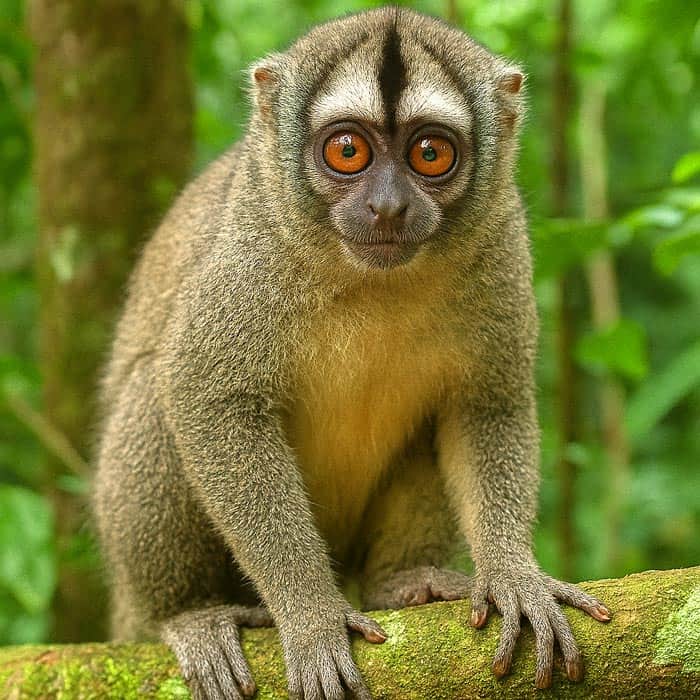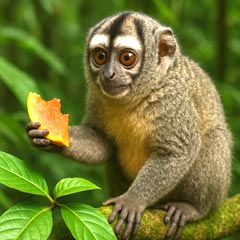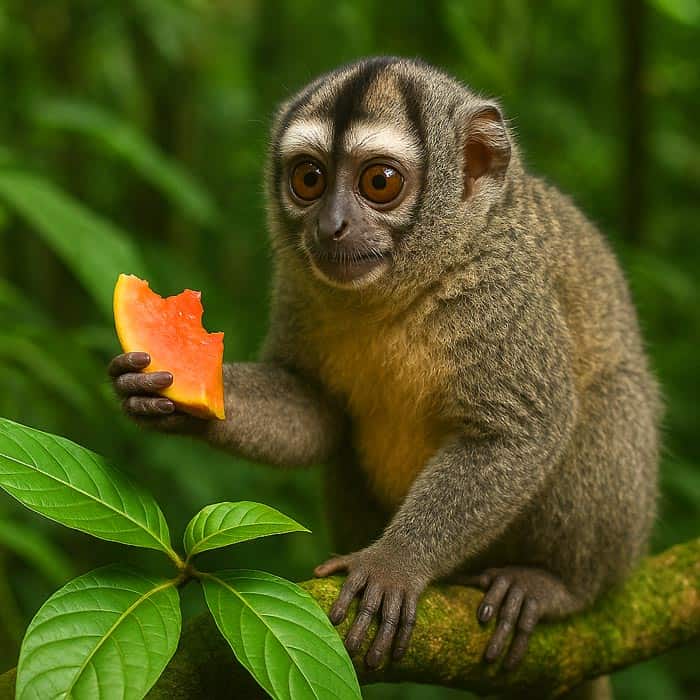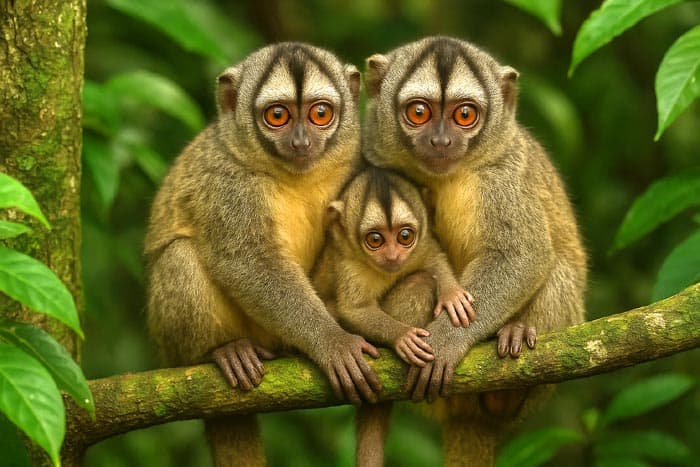
| Animalia | Primates | Aotidae | Aotus | Aotus griseimembra |


- Common Name: Gray-handed night monkey.
- Family: Aotidae
- Body Dimensions: 24 to 37 centimeters.
- Habitat: Rainforests
- Diet: Frugivorous
- Native Countries: Colombia, Venezuela, and Panama.
- Classification Year: 1912
- Taxonomist: Daniel Giraud Elliot
- IUCN Status: Vulnerable
The gray-handed night monkey (Aotus griseimembra), also known as the grey-handed night monkey or the gray-handed owl monkey, is a small, nocturnal primate native to northern South America.
This species belongs to the family Aotidae and is recognized for its unique adaptations to life in darkness, including large, expressive eyes that enable it to navigate and forage at night. It is only found in Colombia, Venezuela, and Panama.
Table of Contents
Gray-handed Night Monkey Distribution
Gray-handed Night Monkey Characteristics
The gray-handed night monkey exhibits several distinctive physical features that set it apart from other types of primates.
- Adults typically have a head-body length ranging from 24 to 37 centimeters, with tails measuring about the same length or slightly longer.
- Their average weight ranges from 700 to 1,200 grams, with minimal sexual dimorphism; males and females are similar in size and appearance.
One of the most striking characteristics of this species is its large, round eyes, which are an adaptation for nocturnal vision.
- Their fur is generally short and dense, with a coloration that varies from grayish to brownish on the back and lighter, often yellowish or whitish, on the underparts. The hands and feet are typically gray, which is the origin of their common name.
- It has a relatively short snout and a rounded head, contributing to its endearing facial expression. Its ears are small and partially hidden by fur.
- The tail is non-prehensile, meaning it is not used for grasping, but it aids in balance as the animal moves through the forest canopy. Their limbs are well-adapted for an arboreal lifestyle, with long fingers and toes that provide a strong grip on branches.
Habitat
Gray-handed night monkeys are primarily found in the tropical and subtropical forests of northern Colombia and northwestern Venezuela, with smaller populations also present in Panama.
- They inhabit a variety of forest types, including primary and secondary forests, gallery forests, and even disturbed habitats such as coffee plantations and fragmented woodlands.
- These monkeys are highly arboreal, spending nearly all their lives in the trees. They prefer areas with dense canopy cover, which provides protection from predators and supports their nocturnal lifestyle by offering ample shade during the day.
- The species is adaptable to habitat disturbance, but extensive deforestation and fragmentation pose significant threats to its long-term survival.
Gray-handed night monkeys are typically found at elevations ranging from sea level up to about 4900 feet. However, most populations occur below 3300 feet. Their home ranges are relatively small, and they rely on the availability of fruiting trees and other food resources within their territories.
What Do Gray-bellied Night Monkeys Eat?

The diet of the gray-handed night monkey is primarily frugivorous, meaning that fruit makes up the bulk of its food intake.
- These monkeys are opportunistic feeders and will consume a wide variety of fruits available in their habitat, depending on seasonal availability.
- In addition to fruit, they supplement their diet with leaves, flowers, nectar, and occasionally insects and other small invertebrates.
- Their nocturnal habits influence their foraging behavior, as they search for food during the night when competition with diurnal species is at a minimum. The monkeys use their keen sense of smell and excellent night vision to locate ripe fruit and other edible plant parts in the dark.
Gray-handed night monkeys play an important ecological role as seed dispersers.
- By consuming fruit and excreting seeds in different locations, they help maintain the health and diversity of the forest ecosystem.
- Their diet may also vary depending on the specific habitat they occupy, with individuals in disturbed or fragmented forests sometimes relying more heavily on alternative food sources such as cultivated fruits or leaves.
- This dietary flexibility enables them to survive in a range of environments. Still, it also makes them vulnerable to changes in food availability resulting from habitat loss and degradation.
Breeding Behavior

The gray-handed night monkey exhibits a unique and highly structured breeding system centered around monogamy and biparental care.
- Social groups typically consist of a mated pair and their offspring, forming a close-knit family unit. This monogamous pairing is relatively rare among primates and is a defining feature of the species’ social organization.
- Breeding can occur throughout the year, but there may be peaks in births depending on local environmental conditions and food availability.
- After a gestation period of approximately 133 days, the female gives birth to a single infant, although twins are rare. Births typically occur at night, in line with the species’ nocturnal habits.
One of the most remarkable aspects of gray-handed night monkey breeding behavior is the extensive involvement of the male in infant care.
- Shortly after birth, the father assumes primary responsibility for carrying the infant, only passing it to the mother for nursing.
- This high level of paternal care is likely to strengthen the pair bond and increase the survival chances of the offspring. The mother provides nourishment, but the father’s role in carrying and protecting the infant is crucial, especially in the early weeks of life.
As the infant grows, older siblings may also participate in its care, helping to groom and protect the young monkey. This cooperative breeding behavior fosters strong social bonds within the group, ensuring that the infant receives the attention and protection it needs to survive in a challenging environment. Juveniles remain with their family group until they reach sexual maturity. At this point, they typically disperse to form their own family groups.
Conservation Efforts
The gray-handed night monkey is classified as Vulnerable on the IUCN Red List due to ongoing population declines driven primarily by habitat loss, hunting, and capture for the illegal pet trade and biomedical research.
- The species’ distribution is fragmented, and many populations are isolated in small forest patches, making them more susceptible to local extinctions.
- Deforestation for agriculture, cattle ranching, and urban development continues to reduce the amount of suitable habitat available to the gray-handed night monkey. Additionally, the species is sometimes hunted for bushmeat or captured for the pet trade, further threatening its survival.
- In some regions, individuals are also taken from the wild for use in biomedical research, particularly in studies related to malaria, as the species is susceptible to the disease.
Conservation efforts for the gray-handed night monkey focus on protecting and restoring its natural habitat, enforcing laws against illegal hunting and trade, and raising awareness about the species’ ecological importance (e. g., its role as a seed disperser).
Gray-bellied Night Monkey Fun Facts
- Gray-handed night monkeys are among the few strictly nocturnal primate species, with large eyes adapted for seeing in low-light conditions.
- Their dark facial rings and round eyes give them an “owl-like” appearance (which is why they and the other types of monkeys in the Aotus genus (such Gray-bellied Night Monkey) are known as “owl monkeys”).
- Gray-handed night monkeys use a variety of vocalizations to communicate, including soft hoots and grunts, especially during nighttime activities.
- This species is territorial and uses scent marking and vocalizations to defend its home ranges from other groups.
The gray-handed night monkey is a remarkable primate species uniquely adapted to a nocturnal lifestyle in the forests of northern South America.
The survival of this species is not only crucial for the species itself, but also for the broader health of the forests it inhabits. Preserving these unique primates ensures the continued functioning of vital ecological processes and the rich biodiversity of their native regions.
![]()











